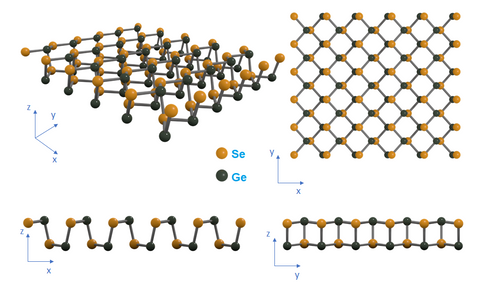Germanium Selenide (GeSe) Crystal
CAS Number 12065-10-0
2D Materials, Low Dimensional Materials, Materials, Post-Transition Metal Chalcogenides (PTMCs), Transition Metal Chalcogenides (TMCs)Low price, high purity 2D metal germanium selenide crystal
For the development of next-generation electronics, optoelectronics, and nanotechnology
Technical Data | MSDS | Structure | Literature and Reviews | Related Products | Resources and Support
Germanium selenide (GeSe), CAS number 12065-10-0, belongs to the Group IV layered post-transition metal chalcogenides (PTMC). It has a puckered layer structure similar to that of black phosphorus (BP). However, unlike BP, each germanium cation is triple-coordinated with a lone electron pair pointing to the inter-layer spacing. The lone electron pair thus is subject to inter-layer coupling to enhance the binding force between layers.
High Purity
High purity Germanium Selenide ≥99.995% crystal
Worldwide shipping
Quick and reliable shipping
Low price
Low price Germanium Selenide
Different Forms
Available in crystals
High quality transition metal chalcogenide monolayers have mostly been fabricated by mechanical and chemical exfoliations from bulk crystals. However, few-to-monolayer GeSe films with direct bandgaps are still hard to obtain by mechanical exfoliation due to the high fragility of GeSe mono-crystalline flakes. Liquid-phase exfoliation of high-purity crystals is an alternative way to prepare GeSe nanosheets or nanoparticles.
The strong covalent bonds within the layer but weak van der Waals interactions between the layers leads to the elimination of dangling bonds and surface states, which provides chemically-inert surfaces and considerably high chemical and environmental stability. So unlike phosphorene, devices based on GeSe provide greater stability and resistance to oxidation.
GeSe is the only Group IV mono-chalcogenide (MX) that has a direct bandgap. It has closely-placed direct and indirect bandgaps that overlap well with the solar spectrum, making it a potential material for photovoltaic and photodetecting applications. Germanium selenide (GeSe) is also the most attractive group IV chalcogenide due to its structural robustness, with isotropic lithiation kinetics and high rate capability.
GeSe is also earth-abundant and environmentally-friendly, which makes it a particularly attractive candidate for applications like semiconductors. Out of its five free-standing polymorph forms, β-GeSe, γ-GeSe, δ-GeSe and ε-GeSe are indirect gap semiconductors, whereas α-GeSe is not.
Bulk single Germanium selenide crystal is most commonly used as sources from which single or few-layer sheets can be obtained via either mechanical or liquid exfoliation. Germanium selenide powder can also be used to prepare GeSe nanosheets and nanoparticles by liquid-exfoliation (normally assisted by sonication).
Technical Data
| CAS Number | 12065-10-0 |
| Chemical Formula | GeSe |
| Molecular Weight | 151.60 g/mol |
| Bandgap | 1.07 eV |
| Preparation | Synthetic - Chemical Vapour Transport (CVT) |
| Structure | Orthorhombic |
| Electronic Properties | 2D semiconductor |
| Melting Point | 667 °C (decompose) |
| Colour | Dark brown |
| Synonyms | Germanium(II) selenide, Selanylidenegermanium |
| Classification / Family | Transition metal monochalcogenides (TMMCs), 2D semiconductor materials, Nano-electronics, Nano-photonics, Photovoltaic, Materials science |
Product Details
| Form | Purity |
|---|---|
| Crystal | ≥99.999% |
Pricing Table
| Product Code | Form | Size/Weight* | Price |
|---|---|---|---|
| M2137A10 | Crystal | Small (≥10 mm2) | $676 ea. |
*typical representative size, areas/dimensions may vary
Shipping is free for qualifying orders.
MSDS Documents
Structure of Germanium Selenide
Germanium selenide (GeSe) belongs to the Group IV layered metal mono-chalcogenides. It has a similar structure to phosphorene, and crystallises in a highly anisotropic layered orthorhombic (distorted NaCl-type) crystal structure with Pnma symmetry. Each primitive unit cell of the orthorhombic crystal structure contains eight atoms organised in adjacent double-puckered layers. The atoms in each double puckered layer bond to their three nearest neighbours by covalent bonds and form a zigzag chain along the direction of the minor axis of the crystal.

Literature and Reviews
- Electronic structure of germanium selenide investigated using ultra-violet photoelectron spectroscopy, P Mishra et al., Semicond. Sci. Technol., 30, 075001 (2015); doi:10.1088/0268-1242/30/7/075001.
- Structural and electronic properties of atomically thin germanium selenide polymorphs, S. Zhang et al., Sci China Mater., 58: 929–935 (2015); doi: 10.1007/s40843-015-0107-5.
- Layered material GeSe and vertical GeSe/MoS2 p-n heterojunctions, W. Yap et al., Nano Res., 11(1): 420–430 (2018); doi: 10.1007/s12274-017-1646-8.
Related Products
We stock a wide range of 2D materials available to purchase online. Please contact us if you cannot find what you are looking for.


 Germanium selenide crystal
Germanium selenide crystal

